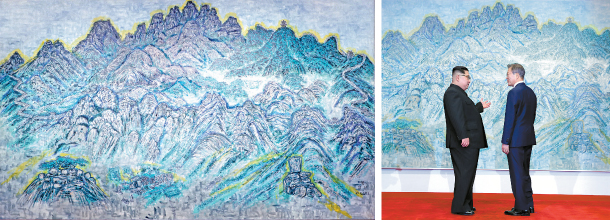Even the summit’s artwork had hidden messages : Blue House chose carefully and had one piece specially created

Above, North Korean leader Kim Jong-un asks South Korean President Moon Jae-in about a painting hanging in Peace House in Panmunjom during the inter-Korean summit on Friday. The landscape painting “Mount Bukhan,” left, was by South Korean artist Min Joung-ki. [JOINT PRESS CORPS]
Also in the spotlight: the artworks hanging behind them.
According to the Blue House, all the works hanging in Peace House during the summit were deliberately selected and installed for symbolic reasons. In this article, the Korea JoongAng Daily selects some to explain the context and introduce the artists who created them.
Among the works, the first one in which North Korean leader Kim Jong-un expressed interest was the spectacular 4.5-meter (14.7-foot) landscape painting “Mount Bukhan” by South Korean artist Min Joung-ki. Pointing to the painting, which depicts a panoramic view of the mountain in northern Seoul, Kim asked South Korean President Moon Jae-in, “What technique was used to paint this?”
Moon replied, “This is a Western[-style] painting but it was painted with our [traditional] East Asian techniques.”

“Sanun,” a 2009 woodblock print by South Korean artist Kim Joon-kwon, is installed behind the table holding the visitor’s book. [JOINT PRESS CORPS]
“I feel more than satisfied to see my work in a very important historic scene,” the artist added.
Min, who belonged to the Minjung (People’s) art movement in the 1980s, linked to social realism, has focused on landscapes since the 1990s. The artist is well known for not only combining diverse perspectives but also sometimes overlapping the historical past with the present of a site he paints.
Regarding the tradition of multiple viewpoints in East Asian landscapes, the famous British painter David Hockney repeatedly said it enables the viewers to travel into nature in the paintings, while Western landscapes with one fixed viewpoint force the viewers to stay in front of the nature.
In accordance with such a view, the Blue House wrote on its blog, “By hanging the painting on the first floor lobby of Peace House, we mean to invite the first-ever North Korean leader coming to South Korean territory into a famous mountain of Seoul.”

The 7-meter (23-foot) painting that depicts Mount Kumgang in North Korea, hanging in the meeting room, is a work by South Korean artist Shin Jang-sik. [JOINT PRESS CORPS]
It carries the image of a preface drawn by calligrapher Kim Eung-hyeon (1927-2007) for “Hunminjeongeum,” a book King Sejong (1397-1450) and his scholars wrote to explain the Korean alphabet of hangul, which they invented. (Hunminjeongeum was the initial name of Hangul.) Photographer Kim took pictures of the calligraphy and colored two of the consonants in the text, which are the initials of the two Koreas’ leaders surnames, blue and red.
Moon explained that the two words that included the colored consonants are “communicate” and “create.” North Korean leader Kim replied, “You carefully considered such details.”
The two leaders also looked closely at a huge painting of Mount Kumgang in the meeting room on the second floor and conversed about it. Shin Jang-sik, who created the painting in 2001, said in an interview with the JoongAng Ilbo, “I made the painting 7 meters wide to express the spirit of Korean people.”
Shin’s nickname is “Mount Kumgang painter” because the 59-year-old South Korean artist has focused on depicting the famous mountain in North Korea since the 1990s. The painting’s title is “Mount Kumgang view from Sangpaldam.” The artist said the scenery viewed at the Sangpaldam, a valley with eight ponds, is one of the most beautiful views of Mount Kumgang.

In the banquet room hangs the painting “From Dumu Port to Cape Jangsan” by artist Shin Tae-soo, which depicts the scenery around Baengnyeong Island.[JOINT PRESS CORPS]
Among other works that attracted the attention of the two leaders were a black-and-white work behind the table holding the visitor’s book on the first floor, and a seascape hanging in the banquet room on the third floor.
The former work is “Sanun,” which means “resonance of mountains,” a woodblock print created by Kim Joon-kwon in 2009. Kim, 62, also belongs to the Minjung art movement and is a pioneer of woodblock prints of landscapes in Korea. His prints are famous for having the feel of East Asian ink paintings.
The seascape is a painting by Shin Tae-soo entitled “From Dumu Port to Cape Jangsan” that depicts the Yellow Sea around Baengnyeong Island just south of the Northern Limit Line. “The installation of the painting comes from our hope we should make the island a place of peace,” the Blue House wrote.
by MOON SO-YOUNG
[symoon@joongang.co.kr]










with the Korea JoongAng Daily
To write comments, please log in to one of the accounts.
Standards Board Policy (0/250자)